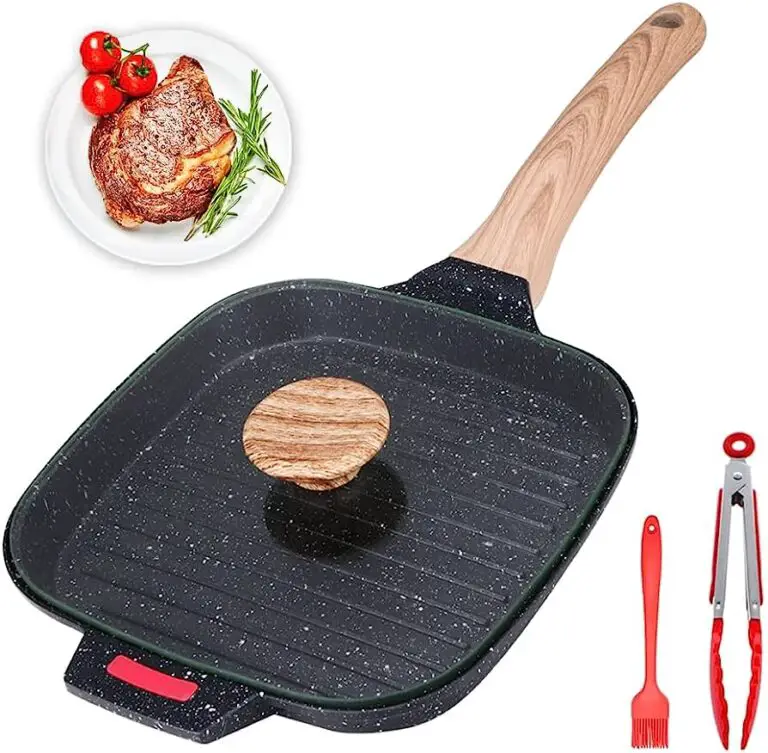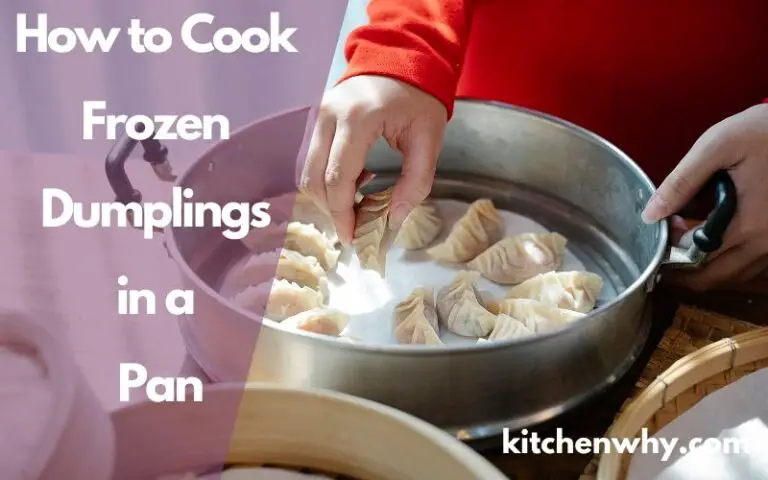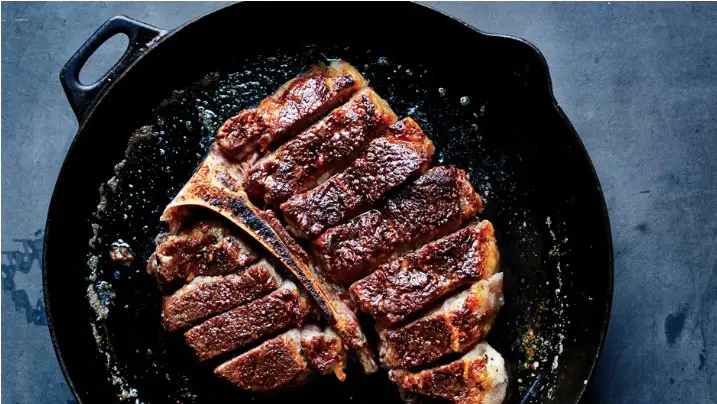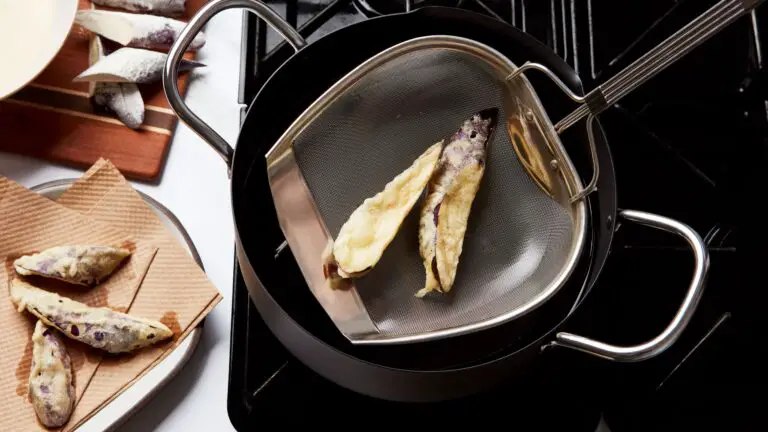Why Does Fish Stick to Pan When Frying? Discover the Answer!

Fish tends to stick to the pan when frying because of the high protein content in fish flesh, which can react with heat and cause sticking. Additionally, the lack of proper preheating, insufficient oil, and using a nonstick pan can also contribute to fish sticking to the pan.
When frying fish, it is important to preheat the pan properly, use enough oil to create a protective barrier and avoid overcrowding the pan to ensure the fish cooks evenly and doesn’t stick. By following these tips, you can achieve perfectly cooked, non-sticky fish every time you fry it.
Why Does Fish Stick to Pan When Frying?
Fish can stick to the pan when frying due to several reasons:
- Insufficient Preheating: If the pan is not preheated properly before adding the fish, it can lead to sticking. When the fish comes in contact with a cold surface, proteins in the fish tend to bond with the metal, causing it to adhere.
- Not Using Enough Oil or Non-Stick Coating: Using an inadequate amount of oil or not using a non-stick pan can result in the fish sticking. A non-stick surface or enough oil helps create a barrier between the fish and the pan, reducing the chances of sticking.
- Moisture Content: Excess moisture on the surface of the fish can cause it to stick. When water comes into contact with the hot pan, it can create steam, making the fish more likely to stick.
- Moving the Fish Too Early: When you place the fish in the pan, it initially sticks, but as it cooks, it forms a crust and releases naturally. Trying to move the fish too early can cause it to tear and stick even more.
- Fish Protein Structure: Some types of fish have a higher protein content or delicate protein structure that can make them prone to sticking.
To minimize sticking when frying fish, consider the following tips:
- Preheat the pan properly over medium-high heat before adding oil and fish.
- Use a non-stick pan or add enough oil to coat the pan’s surface.
- Pat the fish dry with paper towels to reduce surface moisture before adding it to the pan.
- Allow the fish to cook for a few minutes before attempting to move or flip it.
- Gently loosen the fish with a spatula if you need to flip it, rather than forcefully prying it off the pan.
By following these guidelines, you can enjoy perfectly fried fish without the hassle of it sticking to the pan.

Credit: madeincookware.com
The Science Behind Fish Sticking To The Pan
Have you ever wondered why fish sometimes sticks to the pan when frying? The answer lies in the fascinating science behind it. From the physical properties of the fish to the role of heat and the pan surface, understanding the factors at play can help you achieve perfectly cooked fish without the frustration of it sticking.
So, let’s dive into the intriguing details and uncover the secrets behind this common culinary conundrum.
Explain The Physical Properties Of Fish That Contribute To Sticking.
- Fish is naturally moist, with a high water content, which can make it prone to sticking to the pan.
- Its delicate flesh and tendency to flake can make it more susceptible to stickiness.
- The skin of the fish, depending on the variety, may contain oils that can further increase the likelihood of sticking.
Discuss The Moisture Content In Fish.
- Fish contains a significant amount of moisture, which is released during the cooking process.
- As the fish cooks, this moisture can interact with the pan surface, causing it to stick.
Highlight The Protein Composition In Fish.
- Fish is rich in proteins, which play a crucial role in its texture and structure.
- Proteins in fish can denature under high heat, causing them to bind together and potentially stick to the pan.
Explore The Role Of Heat And Its Effects On Fish During Frying.
- When fish is subjected to high heat, the proteins undergo structural changes.
- The heat causes the proteins to denature, altering their shape and bonding behavior.
- These changes can lead to the fish sticking to the pan as the proteins interact with the pan surface.
Explain How The High Temperature Causes Proteins To Denature.
- High heat disrupts the hydrogen bonds that maintain the protein’s structure.
- As a result, the proteins unfold and lose their original shape.
- This denaturation can make the proteins more likely to adhere to the pan.
Discuss The Formation Of A Maillard Reaction And Its Impact On Sticking.
- The maillard reaction occurs when heat interacts with proteins and sugars in the fish.
- This reaction creates the browning and flavor development that is desired during cooking.
- However, the byproducts of the maillard reaction, such as sugars and proteins, can contribute to sticking when they interact with the pan surface.
Provide A Clear Explanation Of The Relationship Between Fish, Heat, And The Pan Surface.
- As the fish is exposed to heat, its proteins denature and interact with the pan surface.
- The heat causes the moisture in the fish to evaporate, leaving a layer of protein and other compounds that can stick to the pan.
- The nature of the pan surface, whether it is non-stick or not, can also influence the degree of sticking.
Now that we’ve uncovered the science behind fish sticking to the pan when frying, you can apply this knowledge to your cooking techniques. By understanding the physical properties of fish, the moisture content, and the role of heat, you’ll be better equipped to prevent sticking and achieve perfectly cooked fish every time.
So, grab your favorite fish fillets and get ready to fry them without any worries of sticking to the pan.
Understanding The Role Of The Pan In Fish Sticking
When it comes to frying fish, one of the most frustrating things is when it sticks to the pan. This not only makes flipping difficult, but it can also ruin the presentation of the dish. Understanding the role of the pan in fish sticking is crucial in order to achieve perfectly crispy and non-sticky results.
In this section, we will discuss the different types of pans commonly used for frying fish, analyze the characteristics of non-stick pans and their impact on sticking, highlight the role of stainless steel or cast-iron pans, delve into the importance of preheating the pan, and discuss the impact of insufficient or excessive oil in the pan.
Discuss The Different Types Of Pans Commonly Used For Frying Fish:
- Stainless steel pans: These pans are popular for their durability and even heat distribution, but they tend to have poor non-stick properties, making fish stick more easily.
- Non-stick pans: Designed specifically to prevent sticking, non-stick pans have a coating that allows the fish to slide off easily. However, some non-stick coatings may wear off over time, leading to increased sticking.
- Cast-iron pans: Known for their excellent heat retention and even cooking, cast-iron pans require seasoning to develop a natural non-stick surface. Once properly seasoned, they can provide a great cooking experience for frying fish.
Analyze The Characteristics Of Non-Stick Pans And Their Impact On Sticking:
- Non-stick coating: The slick surface of non-stick pans prevents food from clinging to the pan, reducing the chances of fish sticking.
- Wear and tear: Over time, non-stick coatings can degrade or scratch, leading to decreased non-stick properties and increased sticking.
- Temperature limitations: Non-stick pans have specific temperature limitations, and exceeding them can cause the coating to deteriorate, resulting in fish sticking.
Highlight The Role Of Stainless Steel Or Cast-Iron Pans In Regards To Fish Sticking:
- Stainless steel pans: Due to their poor non-stick properties, fish is more likely to stick to stainless steel pans. Extra care and attention are needed when frying fish in these pans to prevent sticking.
- Cast-iron pans: Once properly seasoned, cast-iron pans develop a natural non-stick surface. This seasoned layer prevents fish from sticking and allows for a more enjoyable frying experience.
Delve Into The Importance Of Preheating The Pan And Its Influence On Stickiness:
- Preheating the pan: Preheating the pan before adding the oil and fish is crucial. It allows the surface of the pan to reach an even temperature, reducing the chances of fish sticking.
- Heat distribution: When the pan is preheated, it ensures that the entire cooking surface is evenly heated. This helps in creating a non-stick environment for frying fish.
Discuss The Impact Of Insufficient Or Excessive Oil In The Pan When Frying Fish:
- Insufficient oil: When there is not enough oil in the pan, there is a greater chance of the fish sticking. The fish needs a thin layer of oil to create a barrier between the fish and the pan.
- Excessive oil: While too little oil can lead to sticking, using excessive oil can also be problematic. It can cause the fish to become greasy and may lead to splattering during frying.
Understanding the role of the pan is crucial in preventing fish from sticking when frying. Factors such as the type of pan used, preheating, and oil quantity can greatly influence the stickiness of the fish. By selecting the right pan, properly preheating it, and using an appropriate amount of oil, you can achieve perfectly cooked and non-sticky fish every time.
Factors Affecting Fish Stickiness And How To Minimize It
Fish sticking to the pan while frying can be frustrating, but understanding the factors that contribute to this issue can help minimize it. One of the key culprits is the breading or batter used to coat the fish before frying.
Different coatings can have a significant impact on the cooking process and stickiness.
Analyze The Impact Of Breading Or Batter On Fish Sticking To The Pan:
- The thickness and texture of the breading or batter can affect how it adheres to the fish and the pan. A thicker coating may take longer to cook evenly, increasing the chances of sticking.
- The ingredients used in the breading or batter can also affect the stickiness. Ingredients like flour or cornstarch can create a crispier crust, while ingredients with a higher fat content, like buttermilk or eggs, can lead to a stickier coating.
To minimize sticking when using breading or batter, consider the following tips:
- Ensure your fish is properly dried before applying the coating. Excess moisture can cause the coating to become soggy, increasing the likelihood of sticking.
- Adjust the heat to ensure you’re cooking at the optimal temperature. Higher heat can help prevent the coating from becoming saturated with oil, reducing stickiness.
- Use the right amount of oil in the pan. Adding too much oil can lead to a greasier coating, which can make it more susceptible to sticking.
- Consider adding a protective layer to the pan surface before frying. This can help create a barrier between the fish and the pan, reducing the chances of sticking.
Apart from the coating, the freshness and moisture content of the fish itself also play a role in stickiness.
Discuss The Impact Of Fish Freshness And Moisture Content On Stickiness:
- Fresher fish typically has a lower moisture content, which can help reduce stickiness during frying. Opt for fish that is firm and has a bright appearance.
- If using frozen fish, make sure to thaw it properly before frying. Excess moisture from improper thawing can contribute to sticking.
To prevent fish from sticking during frying, keep these tips in mind:
- Thoroughly pat dry the fish before coating and frying. This helps remove any excess moisture that could lead to sticking.
- Use a cooking oil with a high smoke point to ensure it can handle the heat without burning and sticking to the fish.
- Avoid overcrowding the pan, as it can lower the temperature and increase the chances of sticking.
By understanding the impact of breading or batter, as well as the freshness and moisture content of the fish, you can minimize the frustrating issue of fish sticking to the pan while frying. Applying these tips will help you achieve a crispy and delicious fish dish without the headache of sticky residue.
Alternative Cooking Methods To Avoid Fish Sticking
When it comes to frying fish, one of the common problems we face is fish sticking to the pan. This can be frustrating and can ruin the texture and appearance of the fish. But fret not! There are alternative cooking methods that can be used to prevent fish sticking, ensuring you get perfectly cooked fish every time.
We will explore the advantages and disadvantages of baking, grilling, and steaming fish as alternatives, discuss the impact of different cooking surfaces on stickiness, and provide tips and techniques for using these methods effectively.
- Baking: This method involves cooking the fish in the oven, usually on a baking sheet or in a baking dish. The dry, indirect heat of the oven helps to prevent the fish from sticking to the pan. Some advantages of baking fish include:
- Minimal oil or fat is required, making it a healthier option.
- It allows for even cooking and can result in a moist and tender fish.
- Baking allows you to add different flavors and seasonings to enhance the taste of the fish.
- It is a relatively hands-off method, allowing you to prepare other dishes or attend to other tasks while the fish cooks.
- Grilling: Grilling fish over direct heat can also help prevent sticking. The high heat helps to create a sear on the fish, forming a crust that prevents it from sticking to the grill grates. Here are some advantages of grilling fish:
- Grilling imparts a smoky and charred flavor to the fish, enhancing its taste.
- It allows for quick cooking, making it a great option for busy weeknights.
- Grilling fish can be a healthier alternative as it requires minimal added fat.
- The grill marks on the fish add visual appeal to the dish.
- Steaming: Steaming fish involves cooking it over boiling water, either in a steamer basket or wrapped in parchment paper. Steaming is a gentle and moist method of cooking that helps to prevent sticking. Consider the following advantages of steaming fish:
- It preserves the natural flavors and moisture of the fish, resulting in tender and delicate flesh.
- Steaming is a healthy cooking method that requires no added oil or fat.
- It is a versatile technique that allows you to infuse the fish with various flavors by adding herbs, spices, or aromatics to the steaming liquid.
- Steaming is a forgiving method, as it is unlikely to overcook the fish.
Impact Of Different Cooking Surfaces On Stickiness
Different cooking surfaces also play a role in how likely the fish is to stick. For instance:
- On a grill: The direct heat and grill grates create a sear on the fish, reducing the likelihood of sticking.
- In an oven: Baking on a non-stick surface like a silicone baking mat or parchment paper can help prevent sticking.
- In a steam basket: The steam and moisture during steaming prevent the fish from sticking to the basket.
Tips And Techniques For Using Alternative Cooking Methods Effectively
Here are some tips to ensure successful cooking using alternative methods that prevent fish from sticking:
- Preheat the cooking surface adequately before adding the fish.
- Pat the fish dry to remove excess moisture, as moisture can contribute to sticking.
- Brush or spray cooking oil on the fish or cooking surface to create a non-stick barrier.
- Use a fish spatula or a thin metal spatula to gently lift and flip the fish, minimizing the risk of sticking.
- Avoid overcrowding the pan or grill, as it can lead to steaming rather than searing the fish.
By utilizing these alternative cooking methods and implementing the suggested tips and techniques, you can say goodbye to the frustration of fish sticking to the pan. Experiment with baking, grilling, and steaming to achieve perfectly cooked, flavorful fish every time.
Frequently Asked Questions For Why Does Fish Stick To Pan When Frying
Why Does Fish Stick To The Pan When Frying?
When fish sticks to the pan while frying, it’s often due to insufficient oil or the pan not being properly preheated. Fish may also stick if it’s not dry before cooking or if you flip it too soon. To prevent sticking, make sure the pan and fish are adequately prepped and use enough oil.
How Can I Prevent Fish From Sticking To The Pan?
To prevent fish from sticking to the pan when frying, ensure the pan is properly preheated and add enough oil. Pat the fish dry before cooking and avoid flipping it too soon. Using a non-stick pan or coating the fish in flour or breadcrumbs can also help create a barrier and prevent sticking.
What Type Of Oil Is Best For Frying Fish?
For frying fish, it’s best to use oils with a high smoke point, such as vegetable oil, canola oil, or peanut oil. These oils can withstand high temperatures without breaking down and imparting off-flavors to the fish. Avoid using delicate oils like olive oil, as they are not suitable for high-heat cooking.
Why Should Fish Be Dry Before Frying?
Drying the fish before frying helps prevent sticking. When fish is moist, it can create steam when it comes in contact with the hot pan, leading to sticking. Patting the fish dry with paper towels removes excess moisture and allows for a better sear, resulting in less sticking and a crispier texture.
Is It Necessary To Flip The Fish While Frying?
Flipping the fish while frying is crucial for even cooking and achieving a golden crust on both sides. However, it’s essential to wait until the fish naturally releases from the pan before flipping. Trying to flip too soon can cause the fish to stick and break apart.
Patience is key to successfully flipping fish.
Conclusion
Understanding why fish sticks to the pan when frying is key to achieving perfectly cooked fish every time. The main factors causing fish to stick are moisture and inadequate heat. By properly drying the fish before cooking and using a preheated, well-oiled pan, you can minimize sticking.
Additionally, using non-stick pans or adding a thin layer of oil to the pan can further prevent fish from sticking. It is also essential to resist the temptation to move the fish too soon. Allowing it to cook undisturbed for a few minutes will help develop a crispy golden crust that naturally releases the fish from the pan.
Lastly, adjusting the heat and cooking time according to the type and thickness of the fish will result in a delicious, perfectly cooked dish. With these simple tips, you can enjoy a hassle-free frying experience and savor the delicate flavors of perfectly cooked fish.






